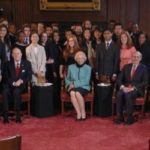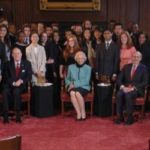Why is jury service important? What is the role of the jury? Jury service is the most direct way of participating in our democracy. In this video, students question federal judges from across the country on the basics of jury service.
Court Shorts: Jury Service, Hands-on Justice
Jury service is an example of hands-on participation in democracy. In a five-minute video, 11 federal judges talk about jury service as an opportunity for citizens to be part of the judicial process that has an impact on daily life. The video, which deals with Constitutional principles and the practicalities of jury service, is part of the Court Shorts video series that includes installments on the rule of law and separation of powers.
Learn About Jury Service
Jury service is a way for U.S. citizens to participate in the judicial process. This resource provides information about juror selections, types of trials heard by jurors, and how judges and juries work together.
Jury Service: Our Duty and Privilege as Citizens
In America, the responsibility to protect individual rights and promote the common good ultimately rests with its citizens, not the government. When citizens participate in thoughtful and responsible ways, the welfare of our constitutional democracy is ensured. While most civic participation is voluntary, the call to serve on a jury is not. It comes as an order by the court.
A Conversation on the Right to Trial by an Impartial Jury
Distance Learning: Civics for Civic Engagement in the Federal Courts
Distance learning activities become civics for civic engagement when federal judges bring the rule of law, separation of powers, judicial independence, and jury service into students’ daily life. Student voice is incorporated into every activity. Teachers and students can explore the pillars of literacy: rule of law, separation of powers, and judicial independence. With the guidance of federal judges and attorney volunteers in virtual court hearings, students learn and practice civil discourse skills as the foundation of effective dispute resolution in the law and in life.
A Conversation on the Constitution: Jury Service
Juror Experiences
Citizens, who had served on juries, were asked how they would describe the experience from a personal point of view. Read their impressions and insights.
FAQs: Juries
The First Amendment and Teens
What does the First Amendment mean in the lives of teens? Over the years, the Supreme Court has struggled with First Amendment issues to determine what constitutes protected speech and, in particular, the speech of students. These activities, which engage all learning styles, apply Supreme Court precedents to relatable, teen scenarios. The modified trial simulations have been well tested in federal courtrooms. The resources are ready for immediate use in courtrooms and classrooms.


